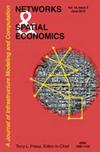The Resource Concentration in Moscow: Impact on the Economy of the Central Federal District
IF 1.5
3区 工程技术
Q3 OPERATIONS RESEARCH & MANAGEMENT SCIENCE
引用次数: 1
Abstract
The article discusses the development of the economy of the regions of the Central Federal District (CFD) in 1998–2020. There are three sectors – Moscow, the Moscow region and the remaining 16 regions. The economic development of these sectors and the impact of resource concentration to the Moscow agglomeration are analyzed. The periphery of the CFD is losing human capital of the highest quality, which decreases the opportunities for its economic development. The purpose of the article is to give a comparative analysis of the economic development of Moscow and other regions of the Central Federal District in 1998–2020. It also examines how the development efficiency of the other 16 regions of the CFD is changing against the background of the outflow of young people to Moscow, the reasons for the change in the growth rates and efficiency of the development of the Moscow economy are being clarified as well. The analysis of the graphs of indicators made it possible to distinguish two periods – before and after the 2008–2009 crisis. We analise influence of selected sectors and structural shifts on the dynamics of labor productivity of the CFD economy, using the methods of economic statistics. Production functions were constructed and the impact of investments on the economic growth rates of the three selected sectors was assessed. During the first period, the Moscow agglomeration was developing successfully, its socio-economic indicators were growing rapidly, and its development efficiency was high. The concentration of resources contributed to faster and more efficient growth of the CFD economy. After the crisis, the migration of the population to the Moscow agglomeration and the concentration of investments has continued, but the growth of the Moscow economy has stopped, and the efficiency of development has decreased sharply. The development of the economy of the third sector of the CFD, which is losing resources, has noticeably slowed down, and efficiency has somewhat decreased. The concentration of resources in Moscow has begun to affect the growth rates of the CFD economy negatively莫斯科资源集中:对中央联邦区经济的影响
本文讨论了1998-2020年中央联邦区各地区的经济发展情况。有三个部门-莫斯科,莫斯科地区和其余16个地区。分析了这些部门的经济发展以及资源集中对莫斯科城市群的影响。CFD外围地区正在流失最优质的人力资本,这减少了其经济发展的机会。本文的目的是对1998-2020年莫斯科和中央联邦区其他地区的经济发展进行比较分析。分析了在年轻人向莫斯科流动的背景下,CFD其他16个地区的发展效率是如何变化的,并阐明了莫斯科经济发展增长率和效率变化的原因。对指标图表的分析使得区分2008-2009年危机前后两个时期成为可能。我们运用经济统计学的方法,分析了选定行业和结构变化对CFD经济劳动生产率动态的影响。构建了生产函数,并评价了投资对选定的三个部门的经济增长率的影响。第一阶段,莫斯科城市群发展顺利,社会经济指标增长较快,发展效率较高;资源的集中促进了CFD经济更快、更高效的增长。危机过后,人口向莫斯科集聚的迁移和投资的集中仍在继续,但莫斯科经济的增长已经停止,发展效率急剧下降。CFD第三部门经济发展明显放缓,资源流失严重,效率有所下降。资源在莫斯科的集中已经开始对差价合约经济的增长率产生负面影响
本文章由计算机程序翻译,如有差异,请以英文原文为准。
求助全文
约1分钟内获得全文
求助全文
来源期刊

Networks & Spatial Economics
社会科学-运筹学与管理科学
CiteScore
4.00
自引率
4.20%
发文量
26
审稿时长
>12 weeks
期刊介绍:
Networks and Spatial Economics (NETS) is devoted to the mathematical and numerical study of economic activities facilitated by human infrastructure, broadly defined to include technologies pertinent to information, telecommunications, the Internet, transportation, energy storage and transmission, and water resources. Because the spatial organization of infrastructure most generally takes the form of networks, the journal encourages submissions that employ a network perspective. However, non-network continuum models are also recognized as an important tradition that has provided great insight into spatial economic phenomena; consequently, the journal welcomes with equal enthusiasm submissions based on continuum models.
The journal welcomes the full spectrum of high quality work in networks and spatial economics including theoretical studies, case studies and algorithmic investigations, as well as manuscripts that combine these aspects. Although not devoted exclusively to theoretical studies, the journal is "theory-friendly". That is, well thought out theoretical analyses of important network and spatial economic problems will be considered without bias even if they do not include case studies or numerical examples.
 求助内容:
求助内容: 应助结果提醒方式:
应助结果提醒方式:


